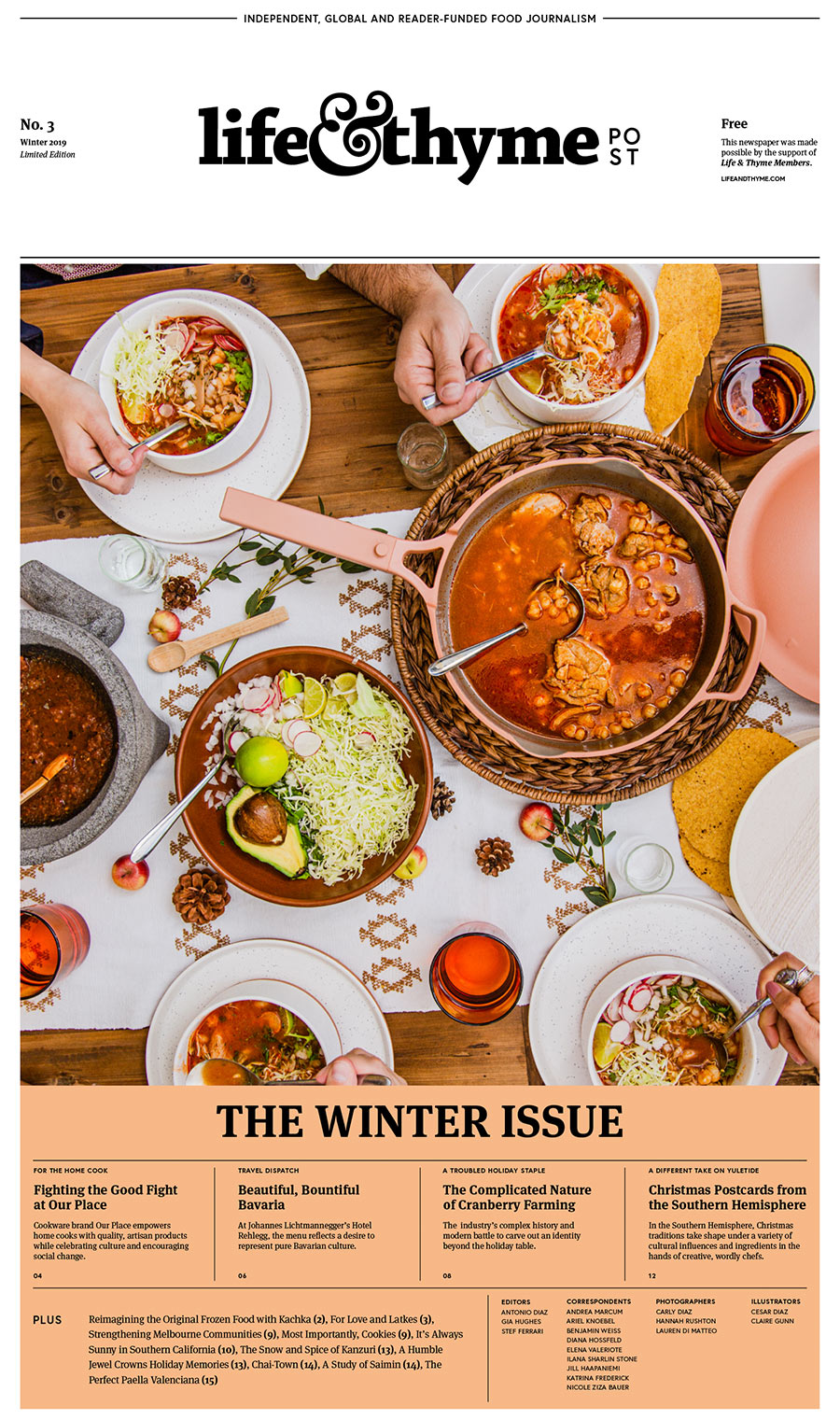
This story can also be found in The Winter Issue of Life & Thyme Post, our limited edition printed newspaper for Life & Thyme members.
Russians tell the fairy tale of Skatert-Samobranka, a folkloric tablecloth that appears clean and empty, but transforms after the utterance of a few magic words. A feast materializes, a spread of delicacies and drinks to quell any pangs of hunger and delight those seated nearby. A meal at Kachka in Portland, Oregon, feels like this fantasy come to life.
Crossing the Kachka threshold into a Slavic world of dim yellow lights, mid-century posters, and Soviet-era ceramics is a deft immersion. There’s even a group of young men tucked into a corner carousing in Russian, an alcoholic tinge to the fog above their table. Were they planted, actors in a Chekhovian farce? The many accolades the restaurant and chef and co-owner Bonnie Frumkin Morales have received may suggest a certain level of seriousness, but for the diner, Kachka is decidedly fun.
Mouthwatering zakuski exit the kitchen as soon as the menus disappear: house-cured fish of all persuasions, pickled watermelon rind, and their famous Herring Under a Fur Coat—a neatly layered tower of herring, potatoes, beets and hard-boiled eggs. By the time plates of dumplings hit the colorful, floral-embroidered tablecloth, expect to be a few shots of vodka and a dozen lively Russian drinking songs deep (the playlist consists of many albums ripped directly from Morales’ parents CD collection). Those pillowy dumplings, under their thin butter-slicked dough, hide a myriad of juicy fillings; Siberian pelmeni stuffed with veal and pork, savory cheese tvarog vareniki, and sour cherry vareniki.

Without those pelmeni, Kachka wouldn’t exist. “[My husband, Israel Morales, co-owner of Kachka] always tells people he feels like I lured him in with pelmeni,” recounts Morales. “We would get home really late from working in restaurants and I would always have store-bought frozen pelmeni in my freezer.” She would dig out sauces and braising liquids leftover from being a cook by day, and boil pelmeni “and put all these crazy toppings on them and sink into the couch at three in the morning. He just loved it.” Falling in love over dumplings spurred conversations about opening a pelmeni concept, an idea that eventually morphed into an extensive menu inspired by Morales’ Belorussian heritage.
Dumpling dough stretches across all fifteen republics of the former USSR, fillings and toppings representing a culinary map of sorts, a guide to what is preferred and plentiful regionally. Pelmeni stuffed with a mixture of meat (pork, beef, deer and even horse) hail from frigid Siberia, where animals grow more easily than greenery. Vareniki, a Ukrainian variety stuffed with vegetables, cheese, and the aforementioned sour cherry—a fruit that finds abundance in the mild southern climate. Manti and monti, specialties of the Caucasus and Central Asia, derive their stuffing from the local proclivity toward lamb and fresh herbs. On top, smetana (sour cream) is nearly universal, in addition to one or more of butter, Russian hot mustard, dill and vinegar. And traveling farther East, soy sauce becomes a more common replacement for the vinegar.
According to Darra Goldstein, founding editor of Gastronomica and author of Beyond the North Wind: Russia in Recipes and Lore, Russian dumplings (filled with mushrooms and buckwheat) show up in written text as far back as the sixteenth century, and likely long predate that mention. Although Goldstein notes dumplings across the globe “probably developed independently,” other origin theories exist. Some posit they were inspired by the wonton, which dates back to the Tang dynasty, or traveled through Mongolia when Genghis Khan’s grandson, leader of the Golden Horde, occupied an area that is now Ukraine, Kazakhstan and part of Russia. Pelmeni do bear a resemblance to the Mongolian buuz.
Whatever the route, pelmeni were perfectly suited for Russia’s long, dark winters. Morales dubs them “the original frozen food,” as dumplings would be made in vast quantities at the onset of winter and left to freeze outside. Preserved in the snow, dumplings could be enjoyed as a quick and nutritious meal all season long. So portable and simple to cook, hunters and ice fishermen would pack pelmeni to boil over an open fire for sustenance.
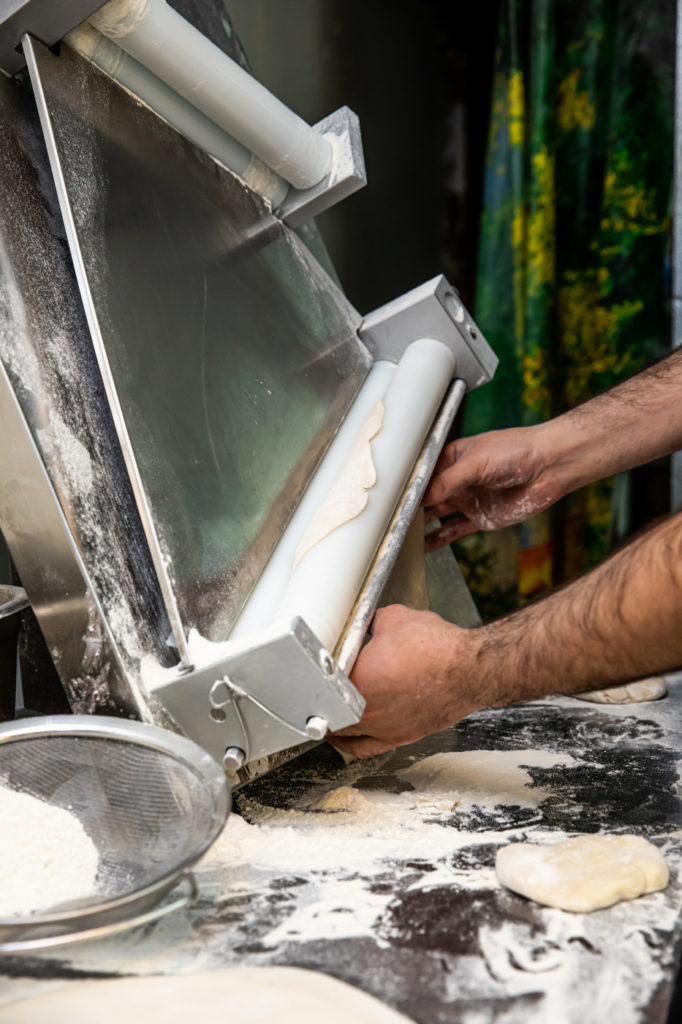
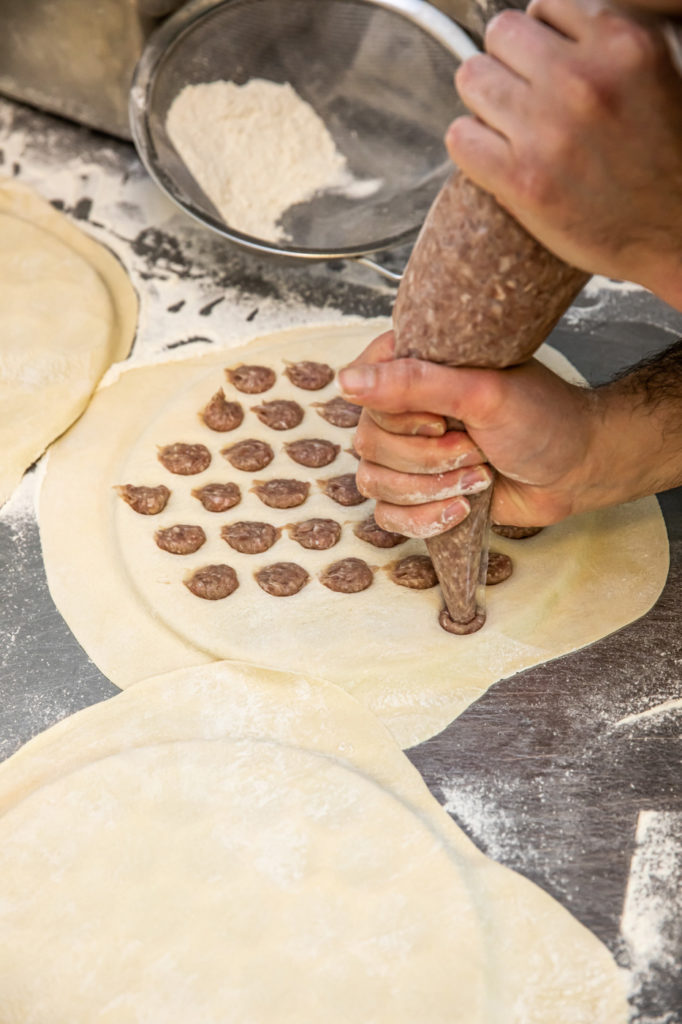

Family marathons once devoted to shaping this beloved food dissolved with the rise of the Soviet Union and the call to relieve women of such frivolous, time-wasting activities. The Lenin-backed 1923 propaganda pamphlet Down with the Private Kitchen extolled the virtues of exchanging home food preparation for proletariat work. Meanwhile, housing was being converted and divided into tiny multi-family apartments surrounding a single communal kitchen, effectively discouraging drawn-out meal preparation. With the push to get the workforce out of the kitchen, pelmeni proved a worthy ally. Their replicability and brief cook time made them an apt candidate for factory assembly. By mid-century, new techniques of mass-production, flash-freezing, and pre-packaging adopted from the U.S. turned once time-consuming babushka fare into university student dream food. Fast-food cafeterias—pelmennye—sprung up across the country, where they remain to this day, serving monotonous pelmeni to the masses. “The pelmeni weren’t of the highest quality but were totally satisfying,” adds Goldstein. “Especially when it was cold outside—the rooms were always hot and steamy.”
Morales’ parents—her father born in 1945, her mother in 1953—grew up during the height of the Soviet Union. They recall pelmeni as the pre-packaged convenience food it became, but additionally owned a pelmenitsa, a honeycomb-shaped tabletop device designed to make thirty-seven identical dumplings at a time. In true Soviet-era fashion, the metal mold maximized efficiency in the kitchen and expended the least amount of material possible, a perfect example—as Morales notes in the Kachka cookbook—of “striving toward a utopian future for all.” Although Morales does not recall her parents ever using their pelmenitsa, they packed the heavy contraption in their suitcases when immigrating from what is now Belarus to the United States in 1980, a considerate choice given their precious weight allotment. “I think that’s really interesting what makes the cut,” Morales reflects.
Despite its popularity, the pelmenitsa’s invention and birthplace remain unclear. Morales speculates the reasoning behind its murky genesis might lie with the people. “One of the great ironies of the Soviet supply chain is the minute that something became available and was popular it was instantly not available because they just couldn’t supply so many people,” she muses. “So people would start making them ad hoc. Apparently that was a really common practice. My guess is something very similar happened with pelmenitsas.” Machine shop owners capitalizing on demand and looking to make bread money on the sly would shift production for a day, copying every last detail of a favored product, down to the price stamped into the side. “As a citizen, everything you made was supposed to be for the country,” says Morales. “If you were to [create a black market item], you would want to make it look like it was mass-produced.”
In production almost unchanged today, inexpensive pelmenitsas abound all over the former Soviet Union. Whenever Morales visits Belarus or Russia, she stocks up, swapping out Kachka’s inventory when the edges start to dull after churning out thousands of dumplings every week. She believes the pelmenitsas “make the best dumplings in the world. It’s such a perfect device.” Every single dumpling at Kachka is made in this method.
Employing a pelmenitsa is as far from handmade as Morales is willing to stray for dumpling preparation. Although tempting, amping up production has its limitations. “It would be awesome if we could just buy a machine,” says Morales, citing the industrial workhorses used to manufacture the majority of dumplings on the market. While these options represent countless labor hours for her cooks, she has researched the possibilities and come up short. “There are some real technical constraints,” she explains. Both dough and filling would need to be drier, and the dough thicker. “The pelmenitsa is actually better because you have this perfect seal all the way around instead of a knot anywhere, and you have a minimal amount of dough on the perimeter.”

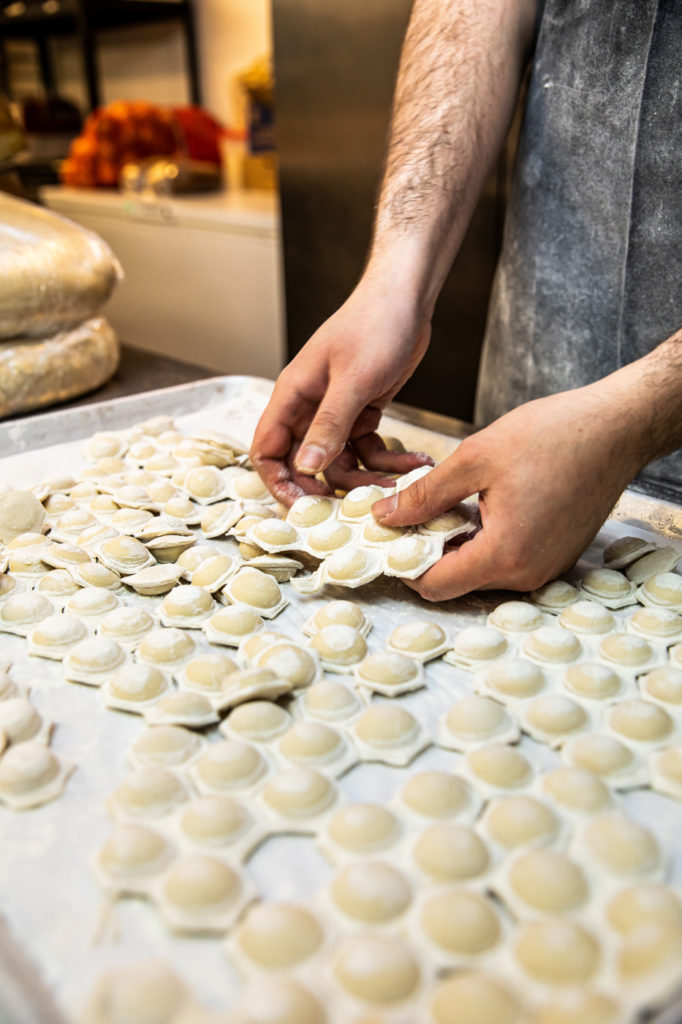
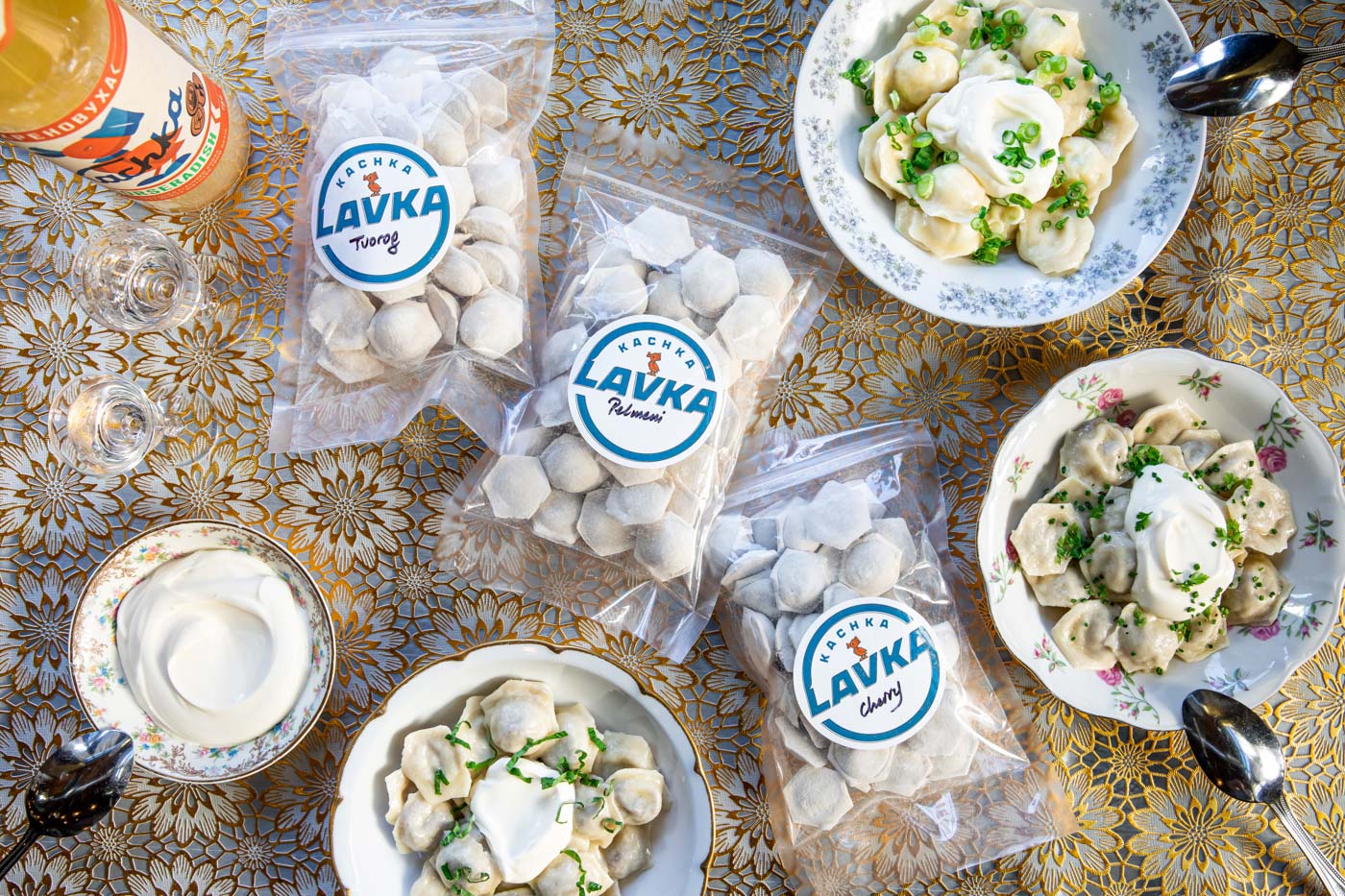
Most Russians—émigrés or not—still buy factory-made dumplings in bulk. Because of this standard, Morales finds herself frequently turning away companies offering their pre-packaged pelmeni and vareniki to the restaurant. Expectation in Russia hasn’t caught up to the values of slow and artisanal food, still rooted in a synthesized past. “For them, it is absolutely mind-boggling that we make our own mustard, our own sour cream, our own bread,” says Morales. “It’s more common for a [Russian] restaurant to serve pelmeni that are purchased than it is for them to be making their own.”
Given the opportunity to reinvigorate the nostalgic dumplings of her youth, Morales has modernized and refined this traditional comfort food for the Kachka table. While she wanted to approximate the meaty Siberian pelmeni of her childhood, she chose to tackle common issues she saw in tvarog vareniki and sour cherry vareniki with her “professional cook’s hat on.” “The tvorog vareniki are a really strong departure from how you would expect tvorog vareniki to be if you grew up eating them,” she says. She opts to emphasize farmer’s cheese’s savoriness. “We mix it with a touch of parmesan and put salt in there and put scallions on top instead of sugar and jam.” For the sour cherry vareniki, an easy solo meal often self-prepared in her teenage years, Morales ultimately found the original lacking of any strong cherry flavor. To address that concern she uses dried sour cherries reconstituted in sour cherry syrup in lieu of the whole pitted fruit, which she says holds too much water. She adds, “It’s playing with that actual raw ingredient a little bit to yield a more pleasurable end result.”
Morales now sells Kachka’s perfected pelmeni and vareniki at the newly opened Kachka Lavka, a Russian market and deli above the main restaurant that also supplies staples from house-made charcuterie and farmer’s cheese to locally-made traditional Ukrainian lollipops. Purchased frozen, the dumplings boil up in four minutes, easily recreating an important part of the Kachka—and Siberian wintertime—experience. It’s an experience Morales hopes will inspire eaters to reconsider stereotypical dining choices. To encourage more diners to add this cuisine to their culinary rolodex, be it in home cooking or as a regular take-out option, she says, is “at the end of the day, our guiding principle.”
She considers possible explanations as to why Russia and its surrounding cuisines haven’t garnered the same recognition as other cuisines, in particular politics and public perception. “Soviet times really did a number on the quality of food as far as availability and shortages,” she says, impressions of Russian food conjuring bread lines and sad, soggy cabbage in consumer minds to this day.
Showing off her family’s delicious, often misunderstood, and incredibly varied cuisine drives Morales and her husband to continue this passion. “We opened Kachka for that reason; we wrote a cookbook for that reason,” she states. “Running a restaurant is not the easiest way to make money, but we do it because we think it’s unacceptable that this food doesn’t get the attention that it should.”
Today, Morales sees a shift in awareness, rippling out from Mother Russia itself. Embargoes placed on Russia after the conflict in Crimea stunted imports of foreign foods and citizens, who have themselves long enjoyed novelties like sushi and caesar salad, and were forced to look inwards for inspiration. “There’s a lot more interest in reviving old foodways, encouraging local food artisans, and you’re starting to see places on the [World’s 50] Best Restaurants list in Russia. That would not have happened ten years ago,” Morales says. “I think we are going to see more of that coming across to the U.S.” Indeed, Kachka is already a shining example that Russian food can succeed in the collective American imagination—pelmeni included.
And just like with the magic tablecloth, when the meal is over the plates, the glasses, the crumbs from the oreshki cookies disappear. Not without a trace though. What lingers is a taste of history, a yearning to return to the revelry not yet left behind, and enough soul warming to face the chill in the air outside.





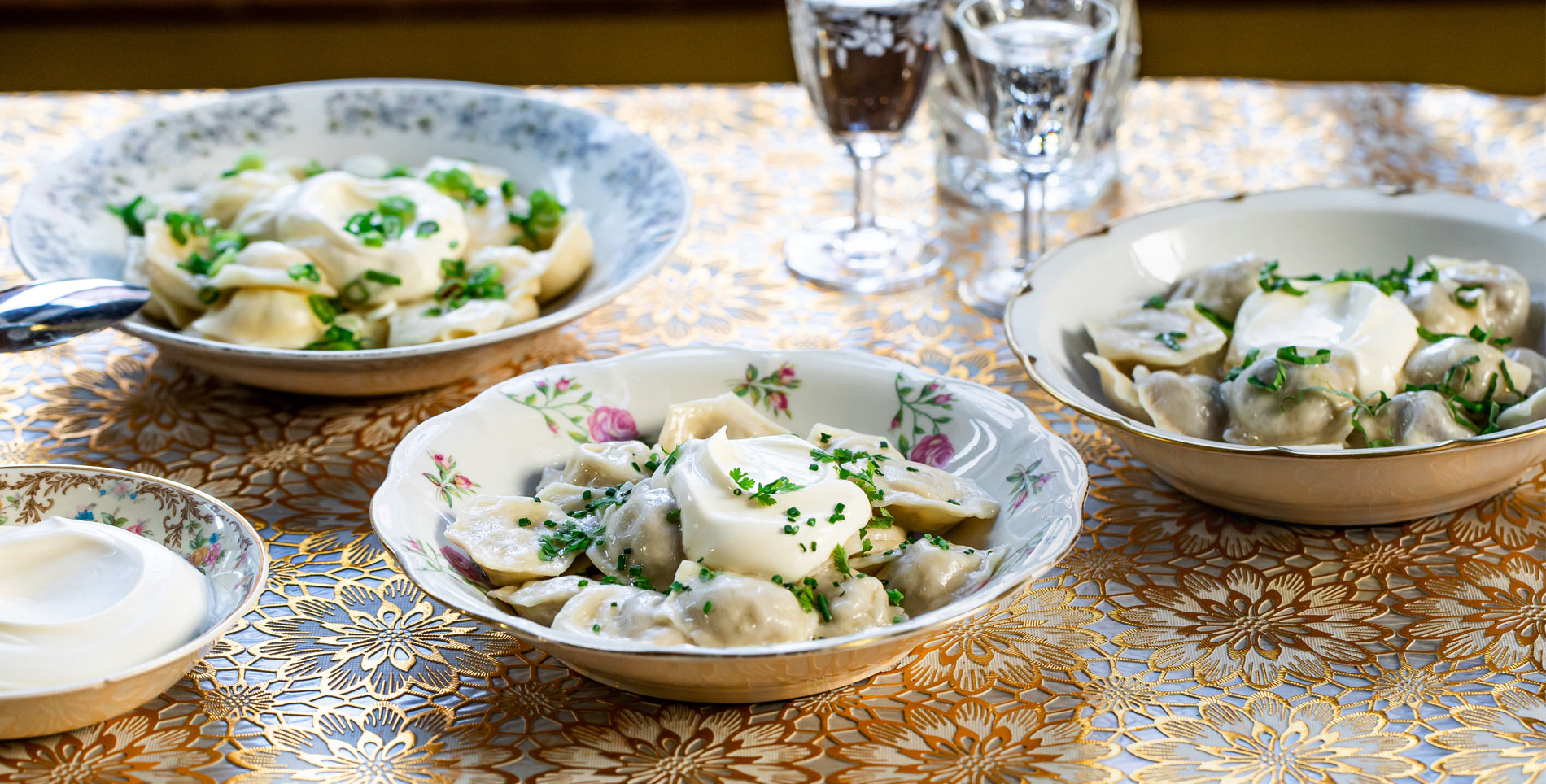

Our comments section is for members only.
Join today to gain exclusive access.